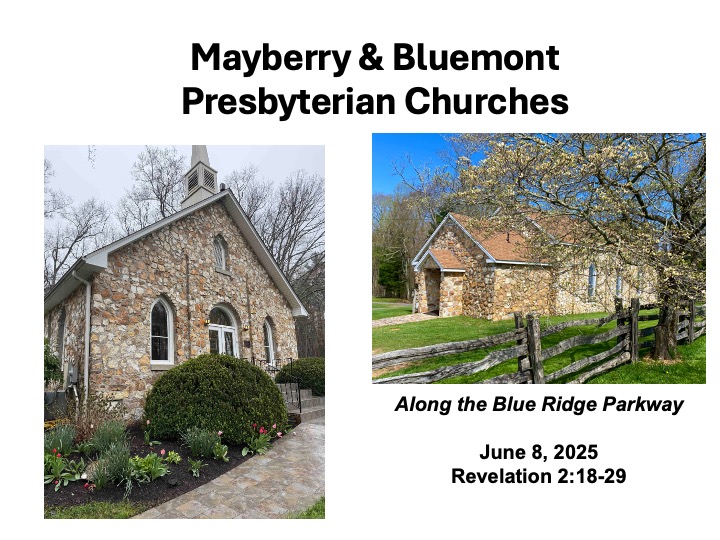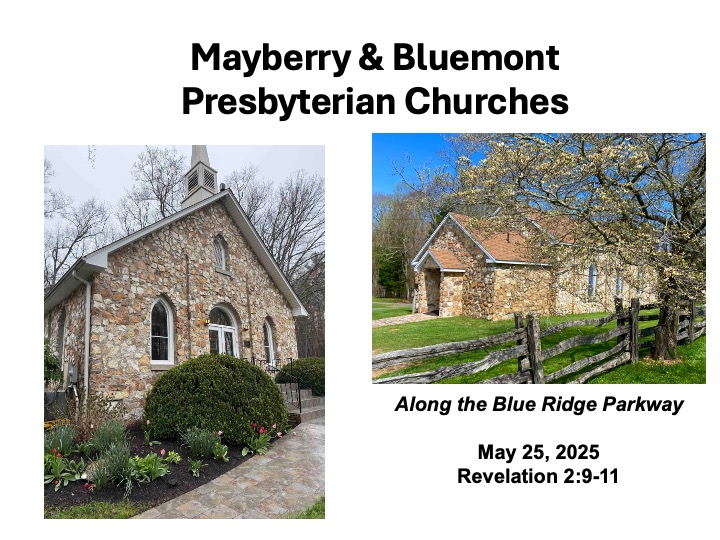Jeff Garrison
Mayberry and Bluemont Churches
July 20, 2025
Revelation 3:14-22
At the beginning of worship:
Back in the 80s, during the dark days of apartheid in South Africa, a wealthy black South African joined the nonviolent movement against apartheid. There weren’t many such people in the country—wealthy blacks that is. One of his white friends asked him why he risked all he had—his wealth, jail time, his life—to fight against this system.
This South African replied he had a greater fear. He feared judgment day, when he would stand in front of the Lord’s throne and be asked to show his scars. And if he had no scars to show, the great judge might ask him, WHY? “Why do you have scars? Is it because there was nothing down there worth fighting for?” He decided it was time to stop looking out for himself and to start serving his brothers and sisters.[1]
When we’re comfortable in life, we become risk adverse. We want to sit back and take it easy. But Christ calls to take a stand, to fight for what is right, good, and noble. Do we?
Before reading the Scripture:
We’ll finish our tour through the seven churches of Revelation with a stop at Laodicea. The city was located about 40 miles southwest of Philadelphia. It’s 100 miles east of Ephesus, where we began our somewhat circular route a couple months ago. If you convert your hand to a map of Asia Minor, you’ll find Laodicea down around the knuckle of your ring finger. Before getting into the passage, let’s run through the seven churches and consider what the overwhelming message was for each church.
We began in Ephesus, a doctrinally correct church who lost their love. Next, we have Smyrna, a city with a church which has a lot going for it but facing persecution. Next, we have the church in Pergamum, which compromised its doctrine. In Thyatira, we have a church that has compromised its morals. The Sardis church is spiritually dead. In Philadelphia, we have a poor church striving to hold on. And today, we’ll look at the lukewarm church, Laodicea.
As we’ve seen in all these letters, knowing something about the city gives insight into Jesus’ words.
Here’s a bit of background for Laodicea. It was a very wealthy city, a center of banking as well as an area with fertile soil and great grasslands for grazing sheep. In addition to banking and farming, textiles were also an important occupation. Founded at a crossroads, water had to be brought in by a series of stone pipes and aqueducts. This is an important clue as we’ll see. There’s a medical school and a pharmaceutical industry in Laodicea, the latter producing a salve for the eyes that was important across the empire.[2] Let’s listen to what Jesus has to say.
Read Revelation 3:14-22.
This passage is an indictment, an accusation against the lifestyle of the Christians in Laodicea. It may well be an indictment of our lifestyle. Christ stands at the door knocking; will we let him in?
This message to the church in Laodicea is like the one to Sardis. Both churches think they are alive but are fooling themselves. Jesus, the faithful, true, and eternal one, knows their works. He knows what they’ve been up too and ain’t happy. “You’re lukewarm,” Jesus says, “neither hot nor cold.”
This opening charge against the Laodiceans has been applied to many churches throughout the ages. But before we get too general with our interpretation, let’s consider some of the background here so we can understand the context for Jesus’ words. After all, why would Jesus say he’d rather have them cold rather than lukewarm? If we’re not careful, we may misinterpret Jesus’ intentions.
A series of hot springs sat across the valley from the Laodicea. Seen as a place of healing, the hot mineral waters provided a cleansing bath and an unpleasant drink. Many used these waters when ill. These springs left mineral deposits which could be seen from Laodicea.
On the other hand, in Colossae, to the northeast, a cold spring poured out delicious water. It was treasured for its refreshing taste. Laodicea, however, had no such springs. Its water came from these distance sources. A series of stone pipes transport the water to the city. By the time it got to Laodicea, the water was warm. With its strong mineral content, the water was hardly fit to drink.
Understanding this background, we can see that the church in Laodicea, as one commentator noted, provided neither “refreshments for the spiritually weary nor healing for the spiritually sick.” They were not doing what they were supposed to be doing and as a result they left a bad taste in Jesus’ mouth. Jesus wants to spit ‘em out, just as the Laodiceans wanted to spit out their local water.[3]
It’s important we understand this. I want to make sure you don’t go away thinking that it’s better to be a “cold Christian” than a lukewarm one. That’s not Jesus’ message. Instead, he’s saying, “Do something worthy of the gifts you’ve received. Be refreshing cold or provide healing warmth. Don’t sit on the fence.”
As I said earlier, Laodicea was a wealthy city. They had so much money that when the city was destroyed by an earthquake in 60 AD, they rebuilt it and didn’t blink. Rome and other cities offered help. Remember, Rome helped Philadelphia rebuild. But Laodicea didn’t need or want help. They were proud of the fact that they could build a new city on their savings. “We’re wealthy,” they thought, “We don’t need any handouts.”
Though the city was wealthy, it was not being judged for its riches. The sin of Laodicea was pride. The city boasted that it was rich; “ah, look at us, we can rebuild without help from Rome.” In addition, they probably want to be indebted to Rome.
The people of the city, and this must have included the Christians, proclaimed their own glory. They saw themselves as ones who’d pulled themselves up by their own sandal-straps. They had created their situation in life; they had built their own fortune and took pride in their accomplishments. This pride kept the city’s inhabitants from seeing their own spiritual poverty.
The other cities in Revelation are condemned for tendencies toward idolatry and were warned to stay away from the idols and the “thrones of Satan.” But Laodicea’s censure is harsher than the others, perhaps because when a people believe they are so great and powerful, they create a god out of themselves. This idolatry can be more destructive than believing in a god of metal or stone or even worshiping Caesar.
Christians in cities like Ephesus and Sardis had a problem with their neighbors enticing them to worship a false god. In Laodicea, there is no evidence of the people believing in anything other than themselves. John instructs the congregation of Laodicea to spend some of their riches, to invest their treasure by buying from Christ pure gold, white linen and ointment for their eyes.
Laodicea indictment shows the real poverty of the city. True wealth comes only from Christ. With him, we can store our wealth in heaven, where it won’t rust, be eaten by moths, or be stolen.[4]Only Christ, who is standing outside their door, can restore their sight.
Does this sound like us? Do we take pride in our own accomplishments? You bet. Do we think we’re self-sufficient? Yep. And you know what; God may have a surprise for us.
I remember talking to a guy once, who was dying. He complained that all this money made no difference. Having been the boss all his life, starting as a young officer during World War 2, he had remained in control of others. He told other people what to do, but in his final couple years he learned the idea of being in control is a myth. When it comes down to our end, our only true security is with God.
We should understand Jesus calls the Laodiceans to do more than nod respectfully at him. After all, that’s all Caesar required; Jesus, however, requires commitment. He wants them, and us, to be either the hot healing waters or the cool refreshing waters. He wants the church not to think too highly of itself, instead to love and minister to others.
Too often we Christians seem to think that just because we’ve been saved, we receive a get into heaven-free card and don’t have to worry about anything. That’s true to a certain extent, but it’s not the purpose behind God’s salvation. God isn’t trying to fill up empty rooms in heaven, God calls us through Jesus Christ because there is work to be done and as Christ’s body on earth, we’re his hands and feet and mouths.
While the Christians in Laodicea will not have to spend any of their treasure to obtain these wondrous gifts from Jesus; it will cost them their fortune. The price Jesus demands is their pride, he demands for the city to stop boasting on how they made themselves rich, instead he demands their lives. They are to live for him; they are to put his concerns at the forefront of their lives; and they are to credit God for whatever successes they enjoy.
As with the other churches, Jesus promises great things to those in Laodicea if they would just open the door and let him in. If they repent, if they change their ways, if they invite Jesus into their lives, he will come in and eat with them. This promise reflects the gracious hospitality of the culture—eating together was considered an honor. Furthermore, Jesus tells them they will have a place on his throne! That’s quite a promise.
Unlike the churches in most of the other cities, Laodicea was financially well off. But they had become too cozy, nothing was worth fighting over. I hope that’s not the case for us. Jesus Christ calls us to do more than just to go to church; he calls us to be his disciples, to be his ambassadors in the world. Jesus calls us to take a stand; he calls us to strive to make the world a better place. Salvation is more than a one-time experience of being born again.[5] That’s just the beginning.
Jesus stands at the door knocking, but the Laodiceans celebrate their glory. With the loudness of the celebration, will they hear the knock? Our Savior also stands metaphorically at our doors, knocking. Do we hear him, or are we too preoccupied? Will we receive him? Or will he have to go down the road and knock on another door? Amen.
[1] I used this story in a sermon in the 90s. I think it came from Alan Boesak, The Finger of God: Sermons on Faith and Socio-Political Responsibility (Maryknoll, NY: Orbis, 1984).
[2] For background on Laodicea, see G. B. Caird, The Revelation of St. John the Divine (New York: Harper & Row, 1966), 56-57; and Robert H. Mounce, The Book of Revelation, NICNT revised (Grand Rapids: Eerdmans, 1997), 106-108.
[3] Mounce, 109.
[4] Matthew 6:19-20.
[5] When I think about salvation as a journey, I think about Peter who was “converted” over and over again as Jesus expanded his vision of what it meant to be a disciple.








